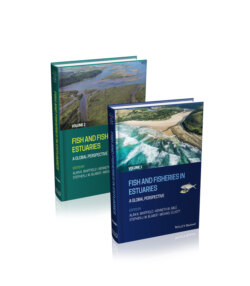Читать книгу Fish and Fisheries in Estuaries - Группа авторов - Страница 31
2.5 Do functional groups drive fish assemblage structure?
ОглавлениеThe above functional group approach shows that, despite the estuarine continuum (i.e. the gradual change in environmental variables such as salinity, water temperature, depth, turbidity, dissolved oxygen and substratum type), it is still possible to group species into categories, each with similar life‐history characteristics, trophic demands on the available resources or modes of reproduction. There are ontogenetic shifts in all estuary‐associated fish taxa, with the guilds changing during their lifespan, especially with respect to feeding.
While taxonomic comparisons between fish assemblages give important information, this is regarded as less important for understanding the functioning of estuaries, especially where different biogeographic regions are being studied or compared. As an example, hyperbenthic invertebrate feeders appear to be more prevalent in northern temperate estuaries, especially in the upper regions of these systems where the common juvenile fishes are consuming mainly mysids and shrimps (Mees & Jones 1997). Similarly, shrimps, mysids and swimming prawns are the dominant prey in the diet of several predatory fish species in the Scheldt Estuary. In contrast, there seem to be no bottom dwelling fish species in southern African estuaries that are exclusively hyperbenthophagic feeders. There are many species that feed on both benthic and hyperbenthic invertebrates (Blaber 1984, Marais 1984, Whitfield 1988), but none that fit neatly into the latter category only.
Using the FMFG classification outlined in this chapter, species that utilise similar food resources can be aggregated, thus providing a greater understanding of fish assemblage structure and trophic functioning in different estuaries. It also lays the foundations for examining the similarities and differences between estuarine fish assemblages in different parts of the world, which may share few or no species in common.
The review by Elliott et al. (2007) pointed to differences between the fish assemblage in different biogeographic areas that are worthy of further study. For example, the limited number of true estuarine residents in southern African estuaries (Whitfield 2019) and much higher proportion completing their life cycle in estuaries in Western Australia (Tweedley et al. 2016) are worthy of further scientific study. In terms of number of individuals, these species collectively make a substantial contribution to the ichthyofauna of many estuaries in southern Africa (Harrison 2005) and particularly so in south‐western Australia, where estuarine‐resident species can represent 93–99% of all fish (Hoeksema et al. 2009).
There is an indication that fish assemblages in adjacent marine systems in particular, and possibly freshwater habitats in certain regions, have a strong influence on the structure and diversity of estuarine communities (Albaret 1999). The repercussions of these links and origins for speciation within estuaries have not been well studied. Although estuaries in their current form are globally of recent origin, there are clear genetic differences between the marine and estuarine populations of certain species, e.g. Cnidoglanis macrocephalus (Watts & Johnson 2004). This also raises the question of the extent to which the speciation of fish can occur in estuarine environments, thereby enhancing the diversity of species within these systems. Unfortunately, the available evidence suggests that fish speciation in estuaries is relatively low (Whitfield 1994), especially when compared to marine and freshwater environments.
